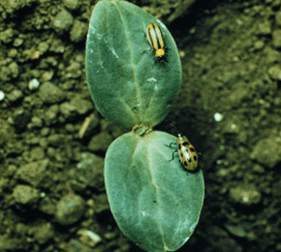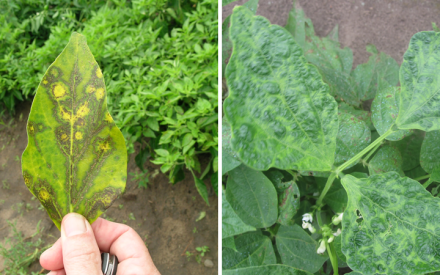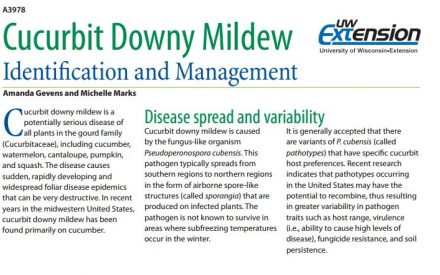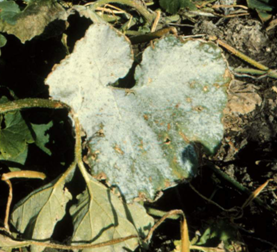Authors: David M. Lowenstein and Russell L. Groves, UW-Madison, Department of Entomology
Last Revised: 05/01/2020
X-number: XHT1092
Striped and spotted cucumber beetles are common pests of vine crops (e.g., cucumber, squash, pumpkin, watermelon) that can cause severe damage to roots, leaves, flowers and fruits, as well as interfere with pollination, leading to reduced fruit set. In Wisconsin, the striped cucumber beetle is the more common of the two insects. In addition to direct damage from their feeding, cucumber beetles can contribute to indirect vine crop damage because they can carry and transmit disease-causing bacteria and viruses.

Appearance: Striped cucumber beetle (Acalymma vittatum) adults are between 3/16 and 1/4 inches long and yellow-green in color with three black stripes running the length of their bodies. They are often confused with western corn rootworm beetles, which are not vine crop pests, but which are often found feeding on vine crop pollen. You can distinguish between these two insects by examining their undersides. Striped cucumber beetles have black abdomens; western corn rootworms have yellow-green abdomens. Spotted cucumber beetle (Diabrotica undecimpunctata) adults are similar in size to striped cucumber beetle adults and are yellow-green except for their black heads and 12 black spots on their backs. Larvae of both types of cucumber beetle live in the soil and are worm-like, are white with a dark head, and have three pairs of legs.
Symptoms and Effects: Cucumber beetle larvae feed on roots and stems, and they can stunt or kill seedlings and transplants when present in large numbers. Adults feed on leaves, petals, pollen, and fruit. Plants in the cotyledon to three leaf stages are especially vulnerable, and high adult populations can completely defoliate plants. Leaf feeding on older plants can lead to moderate to severe defoliation. Fruit feeding can cause cosmetic blemishes that do not reduce fruit edibility but can make fruit less marketable. In addition, cucumber beetle can cause reduced fruit set by congregating in high numbers in flowers (attracted by compounds called cucurbitacins that are produced by the flowers) and disrupting pollination by bees.
In addition to direct damage to plants, cucumber beetles can also inoculate vine crops with Erwinia tracheiphila, the bacterium that causes bacterial wilt (see University of Wisconsin Garden Facts Bacterial Wilt of Cucurbits for details). This disease is typically fatal. Cucumber beetles can also carry and transmit Squash mosaic virus. This virus can lead to stunted plants with distorted, blotchy-colored leaves. The virus can also reduce fruit yield and make fruits malformed and blotchy in color. Home gardeners often find these fruits unattractive and unappetizing. For this reason, commercial growers often find the distorted, blotchy fruits unmarketable.
Life Cycle: Only striped cucumber beetles overwinter in Wisconsin. Adults emerge in mid- to late May and lay eggs in the soil at the base of vine crops. Eggs hatch in 14 to 21 days and larvae feed on roots and underground parts of stems. After two to three weeks of feeding larvae pupate in the soil. Spotted cucumber beetles migrate to northern locations in early to mid-July. This late arrival makes them less likely to be a serious problem. There is one generation of striped and spotted cucumber beetles per year.
Scouting: Early detection and control of cucumber beetles is critical for preventing problems with bacterial wilt. Monitor vine crops for adult beetles two to three times per week early in the season, and weekly thereafter. Pay close attention to the edges of areas where vine crops are grown. This is where cucumber beetles congregate. The threshold for treating for cucumber beetles is one beetle per plant in cucumbers, melons, Hubbard and butternut squash, and younger pumpkins, and five cucumber beetles per plant in watermelon, other varieties of squash, and older pumpkins. If beetle populations exceed 20 per plant, transmission of the bacterial wilt bacterium may occur before insecticide treatments have a chance to control the beetles.
Control:
Cultural: Rotate vine crops with grains, tomatoes, or a non-host cover crop to delay cucumber beetle infestations. Also, consider planting blue Hubbard squash at the edges of areas where you are growing vine crops. This squash variety is particularly attractive to cucumber beetles and will serve as a trap crop where the insects are more likely to feed. If you decide to use a trap crop, it is critical to control cucumber beetles on the trap plants. Otherwise they will eventually spread to other nearby vine crops.
Also consider variety selection when attempting to manage cucumber beetles. Cucumber varieties differ in their attractiveness to the insects. In general, less bitter cucumber varieties are less likely to attract cucumber beetles. In cantaloupe, the varieties ‘Makdimon’ and ‘Rocky Sweet’ are less attractive to these insects. In addition, certain cucumber varieties (e.g., ‘Liberty’ and ’Wisconsin SMR-58’) are tolerant of cucumber beetle feeding damage.
In smaller plantings, consider using floating row covers to keep cucumber beetles from reaching plants. When using floating row covers, be sure to uncover plants when they flower to allow bees to enter and pollinate.
If you see evidence of bacterial wilt, remove diseased plants immediately to prevent further spread.
Chemical: Several insecticides are available to manage cucumber beetles when numbers exceed established thresholds (see above). If beetle populations are particularly high however, chemical treatments may have limited benefit. See Commercial Vegetable Production in Wisconsin for a complete listing of products. Note that not all of the listed products may be available for use in home gardens. If you decide to use insecticides, contact insecticides should be applied to seedlings before transplanting if large numbers of beetles are present early in the season. Systemic insecticides can be applied as either drench applications, or through drip irrigation to target the roots of developing plants. Additional foliar insecticides may be necessary later in the growing season and should be continued as needed after systemic insecticides lose their effectiveness (typically 55 to 70 days after planting) or when established thresholds are exceeded.
Note that cucumber leaves are sensitive and can be burned by insecticide sprays, particularly if they are applied with other pesticides (e.g., fungicides), or if they are applied when daytime temperatures are above 85°F. To avoid harming beneficial insects and pollinators, be sure to spray in the late afternoon or the evening.
Download Article





 Cucumber Mosaic
Cucumber Mosaic Cucurbit Downy Mildew: Identification and Management
Cucurbit Downy Mildew: Identification and Management Growing Pumpkins and Other Vine Crops in Wisconsin
Growing Pumpkins and Other Vine Crops in Wisconsin Powdery Mildew - Vegetables
Powdery Mildew - Vegetables


